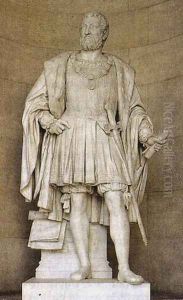Augustin-Alexandre Dumont Paintings
Augustin-Alexandre Dumont, born on August 4, 1801, in Paris, France, was a prominent French sculptor known for his classical style and public monuments. He hailed from a dynasty of sculptors, being the fourth generation to take up the art form. His father, Jacques-Edme Dumont, was also a successful sculptor, which provided Augustin-Alexandre with an environment filled with artistic guidance and exposure from a very young age.
Dumont studied under his father as well as at the École des Beaux-Arts in Paris, where he was trained by the esteemed sculptor Jean-Pierre Cortot. His talent was recognized early on when he won the prestigious Prix de Rome in 1823, which allowed him to study at the French Academy in Rome at the Villa Medici. During his time in Italy, Dumont was deeply influenced by classical art and the works of Renaissance masters, which is evident in the neoclassical style that he later championed.
After returning to France, Dumont continued to build his reputation. He worked on the Arc de Triomphe in Paris, where he created the sculpture 'Le Triomphe de 1810'. Perhaps his most famous work is the 'Venus Victrix', which stands in the Louvre Museum. Dumont also created a number of notable public monuments, including the 'Génie de la Liberté' at the top of the July Column in Paris' Place de la Bastille, which commemorates the July Revolution of 1830.
His works were characterized by a sense of ideal beauty, harmonious proportions, and a smooth finish, which were hallmarks of the neoclassical aesthetic. Dumont's talent earned him numerous commissions and honors, including membership in the Legion of Honour.
Throughout his career, Dumont also served as a professor at the École des Beaux-Arts, imparting his skills and knowledge to the next generation of artists. His impact on French sculpture was significant, as he helped to perpetuate the neoclassical tradition through a period that saw the rise of Romanticism and other competing styles.
Augustin-Alexandre Dumont passed away on January 28, 1884, in Paris. His legacy is enshrined not only in his sculptures but also in the continuation of the Dumont family tradition of sculpting, as his nephew, Georges-Eugène Haussmann, became one of the most famous urban planners in history, radically transforming the cityscape of Paris.
